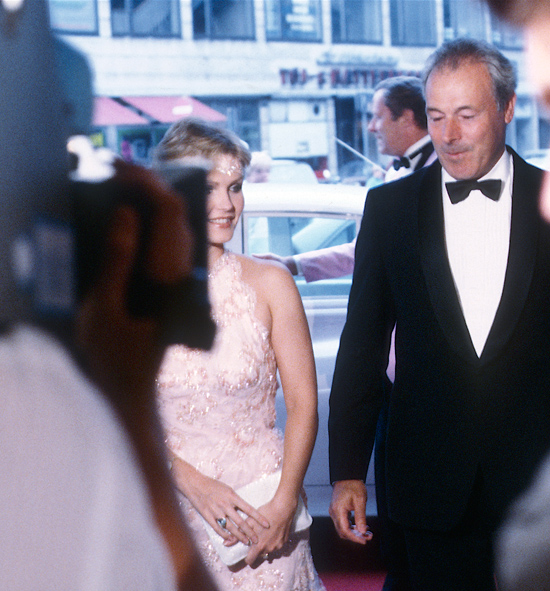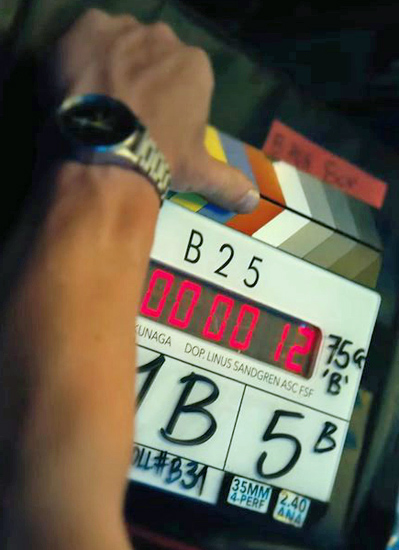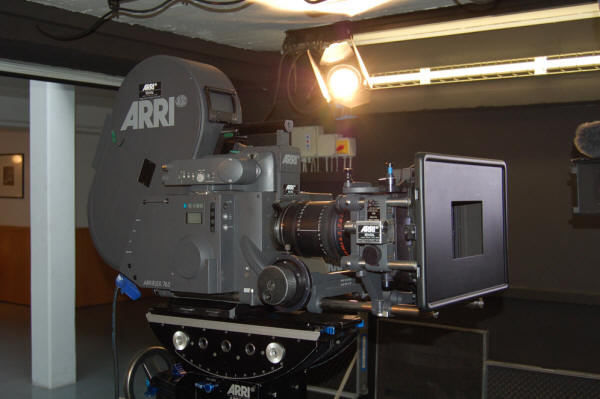"No Time to Die" Filmed (in Parts) in 65mm |
Read more at in70mm.com The 70mm Newsletter |
| Written by: Thomas Hauerslev | Date: 31.03.2019 |
 Glitz,
glamour, TV cameras and red carpets have always been associated with the
premiere of a new James Bond film. From a previous James Bond premiere in
August 1985 ("A View to a Kill"), actress Fiona Fullerton and director John Glen arriving at the
prestigious Imperial Bio in Copenhagen, Denmark. Picture by Thomas Hauerslev Glitz,
glamour, TV cameras and red carpets have always been associated with the
premiere of a new James Bond film. From a previous James Bond premiere in
August 1985 ("A View to a Kill"), actress Fiona Fullerton and director John Glen arriving at the
prestigious Imperial Bio in Copenhagen, Denmark. Picture by Thomas Hauerslevin70mm.com has learned that upcoming James Bond flick working titled "Eclipse", is to be filmed - in parts - in authentic large format IMAX 65mm. The world's largest film format. Filming began this week near Oslo in Norway. The internet rumour factory circulated a picture of a long camera crane arm with a huge camera at the end. The camera looks very much like an IMAX 65mm camera. The new EON motion picture in the long running, and very popular series, stars Daniel Craig and is directed by Cary Fukunaga. Swedish Academy winning Linus Sandgren is Director of Photography. In 2019 Mr. Sandgren also photographed the Ultra Panavision 70 music short film "Who Cares". "Eclipse" is supposed to be filmed primarily with Panavision System 65 cameras in Panavision Super 70, with some sequences in IMAX 65mm. This is Agent 007's first adventure in 65mm, bookending “Octopussy” (10.06.1983) and "Never Say Never Again" (07.10.1983), which were both released in 70mm with 6-track Dolby Stereo. 2019 and 2020 will be busy years for 65mm, with "Star Wars" (20.12.2019), James Bond, “Wonder Woman 1984” (05.06.2020) and Christopher Nolan’s untitled mystery-thriller (17.07.2020) all being photographed on large format film, and of course, "Once Upon a Time in Hollywood", which is rumoured to get a 70mm release in August 2019. All major films in the 70mm release pipeline, which will create excitement in cinemas. |
More in 70mm reading: Photographed on 65mm Film "Death on the Nile" to photographed in Panavision System 65 ARRI 765 Motion pictures photographed in Super Panavision 70 & Panavision System 65 "Once Upon a Time in Hollywood" possibly in 7OMM Chronological premiere list of major 70mm films Internet link: |
"No Time to Die" is the Official Title of Bond
25
|
|
 "No
Time to Die" is not entirely photographed in 65mm. Picture from Facebook "No
Time to Die" is not entirely photographed in 65mm. Picture from FacebookJames Bond Producers, Michael G. Wilson and Barbara Broccoli today (20.08.2019) released the official title of the 25th James Bond adventure, NO TIME TO DIE. The film, from Albert R. Broccoli’s EON Productions, Metro Goldwyn Mayer Studios (MGM), and Universal Pictures International is directed by Cary Joji Fukunaga (Beasts of No Nation, True Detective) and stars Daniel Craig, who returns for his fifth film as Ian Fleming’s James Bond 007. Written by Neal Purvis & Robert Wade (SPECTRE, SKYFALL), Cary Joji Fukunaga, Scott Z. Burns (Contagion, The Bourne Ultimatum) and Phoebe Waller-Bridge (Killing Eve, Fleabag) NO TIME TO DIE is currently in production. The film will be released globally from April 3, 2020 in the UK through Universal Pictures International and in the US on April 8, from MGM via their United Artists Releasing banner. NO TIME TO DIE also stars Rami Malek, Léa Seydoux, Lashana Lynch, Ben Whishaw, Naomie Harris, Billy Magnussen, Ana de Armas, Rory Kinnear, David Dencik, Dali Benssalah with Jeffrey Wright and Ralph Fiennes. In NO TIME TO DIE, Bond has left active service and is enjoying a tranquil life in Jamaica. His peace is short-lived when his old friend Felix Leiter from the CIA turns up asking for help. The mission to rescue a kidnapped scientist turns out to be far more treacherous than expected, leading Bond onto the trail of a mysterious villain armed with dangerous new technology. Other members of the creative team are; Composer Dan Romer, Director of Photography Linus Sandgren, Editors Tom Cross and Elliot Graham, Production Designer Mark Tildesley, Costume Designer Suttirat Larlarb, Hair and Make up Designer Daniel Phillips, Supervising Stunt Coordinator Olivier Schneider, Stunt Coordinator Lee Morrison and Visual Effects Supervisor Charlie Noble. Returning members to the team are; 2nd Unit Director Alexander Witt, Special Effects and Action Vehicles Supervisor Chris Corbould and Casting Director Debbie McWilliams. "No Time to Die" will premiere 8. April 2020 CANCELLED "No Time to Die" will premiere 12. November 2020 in London, UK CANCELLED "No Time to Die" will premiere 2. April 2022 CANCELLED "No Time to Die" will premiere 30. September 2021 to be continued ... |
|
"No Time to Die" Photographic Tech Specs
|
|
 The
majestic ARRI 765 @ Arri in München, 2009. Picture: Thomas Hauerslev The
majestic ARRI 765 @ Arri in München, 2009. Picture: Thomas HauerslevThe majority of "No Time to Die" was captured in anamorphic 35mm — which Sandgren regards as “the classic Bond format” — with Panavision’s Panaflex Millennium XL2. Scenic action sequences, though, were captured in large format. “Five-perf and 15-perf 65mm look spectacular projected,” says Fukunaga, recalling the filmmakers’ initial large-format tests. “Some of the images just leapt off the screen.” The filmmakers used Imax MSM 9802 and Mark IV cameras for these scenes, with [Panavision] System 65 units employed for intimate dialogue because, says Sandgren, “Imax cameras are just a bit too loud.” When the System 65 units were unavailable toward the end of production, the filmmakers turned to the 65mm ARRI 765 — which was more often used by the production’s 2nd unit for dialogue within Imax sequences. When shooting Imax, the camera team framed for both 1.43:1 and 1.9:1 — owing to differences in Imax venues’ projection systems. Five-perf was usually tiled for 1.43:1, according to Sandgren. The production was shot mainly on Kodak Vision3 500T 5219, though Vision3 250D 5207 and 50D 5203 were employed as well, the latter specifically for 35mm-captured day exteriors. The crew shot 1,007 rolls of 35mm — and more than 1.7 million feet of 35mm and 65mm total. |
|
| Go: back - top - back issues - news index Updated 22-01-25 |
